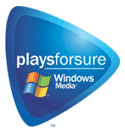Microsoft PlaysForSure: Difference between revisions
Undid revision 368604404 by 207.35.45.3 (talk) rm per WP:EL |
→Overview: Grammar fix. ~~~~ |
||
| Line 10: | Line 10: | ||
==Overview== |
==Overview== |
||
There |
There exist many tests to obtain PlaysForSure certification. The most commonly referenced requirements include the ability to play files encoded in [[Windows Media Audio]] or [[Windows Media Video]] format with [[Windows Media DRM]] [[digital rights management]], used by [[Windows Media Player]] versions 10 and 11. For this, portable devices must implement [[Janus (DRM)|Janus]] (WMDRM-PD), and network-attached devices must implement an interface to [[Cardea (DRM)|Cardea]] (WMDRM-ND). However, other important requirements include time to synchronize a device with a PC, UI performance (time between pressing "play" and hearing music), gapless playback, and so on. |
||
==Content providers who offer PlaysForSure-certified audio== |
==Content providers who offer PlaysForSure-certified audio== |
||
Revision as of 21:25, 17 September 2010

Starting in 2004[1], Microsoft PlaysForSure was a certification given by Microsoft to portable devices and content services which had been tested against several hundred compatibility and performance requirements. These requirements include codec support, DRM support, UI responsiveness, device performance, compatibility with Windows Media Player, synchronization performance, and so on. PlaysForSure certification was available for portable media players, network-attached digital media receivers, and media-enabled mobile phones. The PlaysForSure logo was applied to device packaging as well as to online music stores and online video stores.
In 2007 Microsoft rebranded and scaled back "PlaysForSure"[2][3] into the subset Certified for Windows Vista.[4]
Microsoft's Zune works only with its own content service called Zune Marketplace, not PlaysForSure. Microsoft announced that as of August 31, 2008, PlaysForSure content from their retired MSN Music store would need to be licensed to play before this date or burned permanently to CD[5], although this decision was later reversed.[6] With the exception of Windows Media Player, all of the PlaysForSure offerings are made or run by 3rd-party companies, while Microsoft's Entertainment and Devices Division develops and markets the Zune.
The Zune and PlaysForSure music are both Certified for Windows Vista, yet the Zune cannot play PlaysForSure music purchased from the MSN Music Store.[7]
Overview
There exist many tests to obtain PlaysForSure certification. The most commonly referenced requirements include the ability to play files encoded in Windows Media Audio or Windows Media Video format with Windows Media DRM digital rights management, used by Windows Media Player versions 10 and 11. For this, portable devices must implement Janus (WMDRM-PD), and network-attached devices must implement an interface to Cardea (WMDRM-ND). However, other important requirements include time to synchronize a device with a PC, UI performance (time between pressing "play" and hearing music), gapless playback, and so on.
Content providers who offer PlaysForSure-certified audio
- SoundsRightNow.com
- Napster To Go
Content providers which formerly offered PlaysForSure
- AOL MusicNow (closed)
- Musicmatch Jukebox (closed)
- Yahoo! Music Unlimited (closed)
- Spiralfrog (closed)
- MTV URGE (closed)
- MSN Music (closed)
- Musicmatch Jukebox (closed)
- Wal-Mart Music Downloads (switched to MP3)
- Ruckus Network (closed)
- PassAlong Networks (closed)
- Rhapsody (switched to MP3)[8]
- iMesh (switched to MP3)
- BearShare (switched to MP3)
Content Providers who offer PlaysForSure-certified video
Although there exists a PlaysForSure certification for video, and there are a variety of PlaysForSure-certified portable and network video players which could play PlaysForSure-certified video, were it offered, no online store currently offers video which is certified to play on all PlaysForSure video players.
Hardware Vendors who support PlaysForSure-certified media
|
|
Software which can stream media to PlaysForSure devices
- Windows Media Player versions 10 and 11
- Mezzmo commercial home entertainment software designed for Windows, Sony PlayStation 3 (PS3) or Microsoft Xbox 360. It allows to organize, share and stream the photos, music and video files. Free Mezzmo Player is included in the package.
- TVersity is a free application supporting a variety of formats, including vob-files, enabling streaming of DVD-movies which is not currently possible through Windows Media Player. (Their self-proclaimed goal is to "serve any media to any networked device doing all the necessary conversions to overcome the limitations of any given device".)
- SimpleCenter supports the media devices iPod, Sony PSP, Xbox 360, Nokia N80, N93, USB mass storage and PlaysForSure certified devices".
Criticisms
A 2005 court case strongly criticised the wording of a Microsoft licensing agreement related to portable devices[9]. The license prohibited makers of portable devices compatible with Windows Media Player from using non-Microsoft audio encoding formats. Microsoft indicated that the wording of their license was poorly written due to an oversight by a junior Microsoft employee. Microsoft quickly amended their stringently worded license agreement at the judge's behest.
In a possibly related decision, iriver dropped support for Ogg Vorbis from their latest H10 portable music player (no longer available in retail) in order to market it with PlaysForSure certification. iriver has since added support for Ogg Vorbis (up to Q10),[10] as well as a non-PlaysForSure service, Audible, to their Clix line of portable media players, which remain PlaysForSure-certified.
See also
References
- ^ Microsoft plans branding assault, CNET News
- ^ PlaysForSure Network Media Devices and Windows Vista (WinHEC 2007; 1.7 MB), Slide 13, Retrieved 2007-12-14 from Digital Media Devices and the Windows Logo Program: New Directions for PlaysForSure Testing.
- ^ PlaysForSure Portable Devices and Windows Vista (WinHEC 2007; 3.0 MB), Slide 32. Retrieved 2007-12-14 from Digital Media Devices and the Windows Logo Program: New Directions for PlaysForSure Testing.
- ^ PlaysForSure is growing up!. Retrieved 2007-12-14
- ^ http://arstechnica.com/news.ars/post/20080422-drm-sucks-redux-microsoft-to-nuke-msn-music-drm-keys.html Microsoft to Discontinue PlaysForSure Support
- ^ http://community.winsupersite.com/blogs/paul/archive/2008/06/19/msn-music-store-support-notification.aspx
- ^ BBC NEWS | Technology | Zune problems for MSN customers
- ^ http://arstechnica.com/old/content/2008/06/rhapsody-ditches-drm-with-mp3-store-pats-itself-on-back.ars
- ^ Judge blasts MS bid to monopolize music devices, The Register, 27 Oct, 2005. Accessed 22 Aug 2006.
- ^ iriver Clix (2GB) specifications
